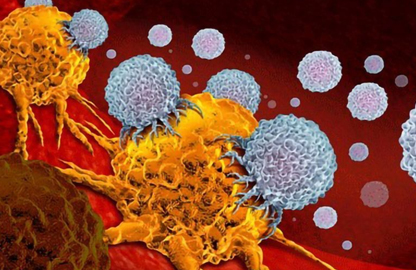

Non-Hodgkin’s lymphoma is a type of cancer that begins in the lymphatic system, which is a part of the body’s germ-fighting immune system. There are many subtypes that fall in this category. Diffuse large B-cell lymphoma and follicular lymphoma are among the most common subtypes.
Signs and symptoms of non-Hodgkin’s lymphoma may include:
- Swollen lymph nodes in your neck, armpits or groin
- Abdominal pain or swelling
- Chest pain, coughing, or trouble breathing
- Persistent fatigue
- Fever
- Night sweats
- Unexplained weight loss
Non-Hodgkin’s lymphoma generally involves the presence of cancerous lymphocytes in your lymph nodes. However, the disease can also spread to other parts of your lymphatic system. These include the lymphatic vessels, tonsils, adenoids, spleen, thymus, and bone marrow. Occasionally, non-Hodgkin’s lymphoma involves organs outside of your lymphatic system.
Most people diagnosed with non-Hodgkin’s lymphoma don’t have any obvious risk factors,and many people who have a risk factor for the disease never develop it.

Some factors that may increase the risk of non-Hodgkin’s lymphoma include:

Tests and procedures used to diagnose non-Hodgkin’s lymphoma include:

Other tests and procedures may be used depending on your situation.
Your doctor uses information from these tests and procedures to determine the subtype of your non-Hodgkin’s lymphoma and which treatments may be most effective.
Treatment
Several non-Hodgkin’s lymphoma treatments are available. Which treatment or combination of treatments is best for you will depend on the particulars of your lymphoma, such as the types of cells involved and whether your lymphoma is aggressive or not. The doctor also considers patient’s overall health and preferences.
If the lymphoma appears to be slow growing (indolent) and doesn’t cause signs and symptoms, patient might not need treatment right away. Instead, the doctor may recommend regular check-ups every few months to monitor the condition and intervene if the cancer advances.
If the non-Hodgkin’s lymphoma is aggressive or causes signs and symptoms, the doctor may recommend treatment. Options may include:

Chemotherapy is a drug treatment that kills cancer cells. It can be given orally or by injection. Chemotherapy drugs can be used alone, in combination with other chemotherapy drugs, or combined with other treatments.
Chemotherapy is a common initial treatment for non-Hodgkin’s lymphoma. It might also be an option if your lymphoma comes back after initial treatments.
Radiation Therapy
Radiation therapy uses high-powered energy beams, such as X-rays and protons, to kill cancer cells. During radiation therapy, patient lies on a table and a large machine moves around, directing the energy beams to specific points on the body.
For certain types of non-Hodgkin’s lymphoma, radiation therapy may be the only treatment needed, particularly if the lymphoma is slow growing and located in just one or two spots. More commonly, radiation is used after chemotherapy to kill any lymphoma cells that might remain. Radiation can be aimed at affected lymph nodes and the nearby area of nodes where the disease might progress.


Targeted Drug Therapy
Targeted drug treatments focus on specific abnormalities present within cancer cells. By blocking these abnormalities, targeted drug treatments can cause cancer cells to die.
For non-Hodgkin’s lymphoma, targeted drugs can be used alone, but are often combined with chemotherapy. This combination can be used as your initial treatment and as a second treatment if your lymphoma comes back.
Engineering Immune Cells to Fight Lymphoma
A specialized treatment called Chimeric Antigen Receptor (CAR)-T cell therapy takes patient’s germ-fighting T cells, engineers them to fight cancer, and infuses them back into the patient’s body.
CAR-T cell therapy might be an option for certain types of B-cell non-Hodgkin’s lymphoma that haven’t responded to other treatments.


Bone Marrow Transplant
Bone marrow transplant, also known as a stem cell transplant, involves using high doses of chemotherapy and radiation to suppress your bone marrow and immune system. Then, healthy bone marrow stem cells from the patient’s body or from a donor are infused into the blood where they travel to the bones and rebuild the bone marrow.
For people with non-Hodgkin’s lymphoma, a bone marrow transplant might be an option if other treatments haven’t helped.
Immunotherapy
Immunotherapy uses the patient’s immune system to fight cancer. The body’s disease-fighting immune system may not attack the cancer because the cancer cells produce proteins that help them hide from the immune system cells. Immunotherapy works by interfering with that process.
Immunotherapy drugs may be an option for certain types of non-Hodgkin’s lymphoma if other treatments haven’t helped.
